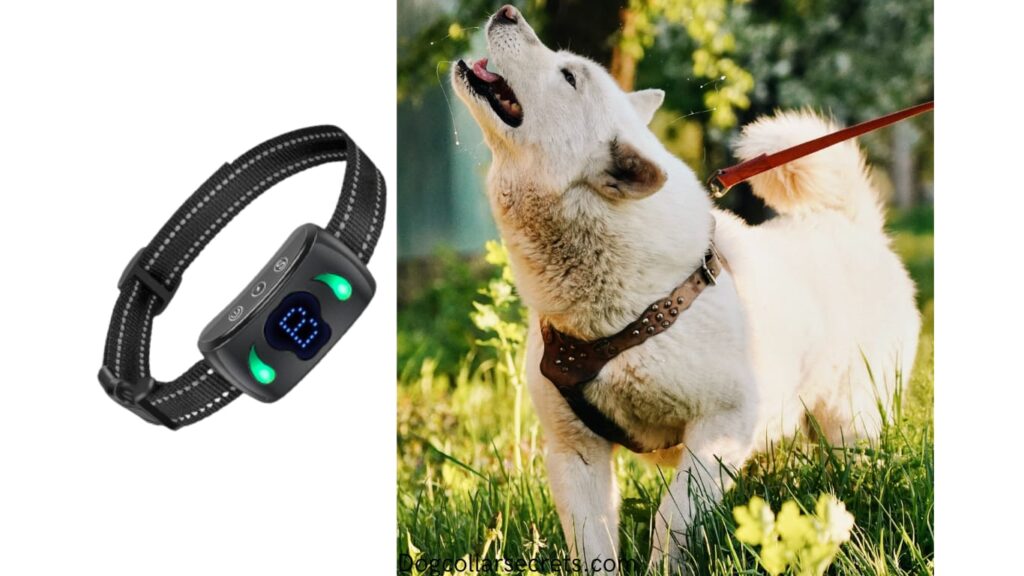Can you leave a bark collar on all night?

Can you leave a bark collar on all night?
Bark collars are specialized devices designed to address excessive barking in dogs. They come in various types, including static/shock, vibration, ultrasonic, and spray collars. These collars are typically activated by the sound or vibrations of a dog’s barking and deliver a corrective stimulus to deter the behavior. While bark collars can be effective tools for training and behavior modification, it’s essential to use them responsibly and considerately to ensure the well-being and comfort of the dog.
“Can you leave a bark collar on all night? This common question addresses the possibility of using bark collars continuously throughout the night. In short, while some collars are made for prolonged use, using one all night can cause harm if not careful. Using a bark collar all night can potentially be harmful to your dog if not managed properly. In the following discussion, we delve into the considerations, safety aspects, and guidelines associated with leaving a bark collar on your dog overnight.”
Can You Leave a Bark Collar on All Night? Bark Collars Guide
Bark collars are gadgets that help address excessive barking in dogs. However, using them around the clock raises concerns about your dog’s safety and well-being. Let’s dive into the details and uncover what you need to know:
Understanding Bark Collars and Their Purpose: Bark collars are devices designed to discourage excessive barking. They work by emitting stimuli like sound, vibration, or mild shocks when the dog barks excessively. The idea is to associate the stimulus with barking, discouraging the behavior.
Safety Considerations for Overnight Use: Leaving a bark collar on your dog overnight can have potential drawbacks. Extended exposure to the corrective stimuli might lead to discomfort, skin irritation, and even stress. It’s vital to consider your dog’s comfort and mental state.
Skin Sensitivity and Irritation: Wearing a collar for an extended period can lead to skin sensitivity issues, especially if the collar’s contact points rub against the skin. It’s crucial to regularly check your dog’s neck for any signs of irritation.
Psychological Impact on the Dog: Continuous exposure to corrective stimuli can negatively impact your dog’s emotional well-being. It might cause anxiety, confusion, or fear, which could counteract the training’s intended purpose.
Monitoring and Balancing: If you’re considering overnight use, closely monitor your dog’s reaction. Remove the collar if you notice signs of discomfort or distress. Balancing training with comfort is essential for effective and humane behavior modification.
Recommended Practices: If you decide to use a bark collar overnight, follow these guidelines:
- Choose Comfortable Collars: Opt for collars designed for prolonged wear, ensuring they’re well-fitted and not too tight.
- Take Breaks: Allow your dog collar-free periods to prevent skin irritation and mental fatigue.
- Consult a Professional: Seek advice from a veterinarian or professional dog trainer to ensure you’re using the collar appropriately.
Alternatives to Overnight Use: Rather than leaving a bark collar on all night, consider alternatives:
- Crate Training: Crating your dog can provide a safe, cozy space, potentially reducing nighttime barking.
- Address Underlying Issues: If barking stems from anxiety or boredom, addressing these root causes can lead to more effective behavior changes.
- Consult a Professional: Seek guidance from experts who can provide tailored advice based on your dog’s specific needs.

What happens if you leave bark collar on too long?
Leaving a bark collar on your dog for extended periods can lead to various negative consequences that affect both their physical and emotional well-being. It’s essential to be aware of these risks to make informed decisions about using bark collars:
Skin Irritation and Discomfort: Leaving a bark collar on for too long can cause skin irritation, especially if the collar’s contact points continuously rub against your dog’s skin. This discomfort can result in redness, itching, and even sores.
Stress and Anxiety: Prolonged exposure to the collar’s corrective stimuli, such as shocks or vibrations, can contribute to heightened stress and anxiety levels in your dog. This can lead to behavioral changes, including increased barking or even withdrawal.
Ineffectiveness of Training: Using a bark collar excessively can reduce its effectiveness in the long run. Your dog might become desensitized to the stimuli, rendering the collar less useful in curbing unwanted barking behavior.
Physical Injuries: Continuous pressure from the collar, especially if it’s too tight, can cause discomfort and potential physical injuries. It’s crucial to ensure the collar is properly fitted to prevent harm.
Behavioral Changes: Leaving a bark collar on for extended periods might result in unintended behavioral changes. Your dog might associate the discomfort with various unrelated factors, leading to confusion and potentially worsening the behavior you intended to correct.
Loss of Positive Association: Using a bark collar excessively can diminish the positive association your dog has with training and interaction. This could impact your overall bond and communication with your furry companion.
Balancing Training and Well-being: To avoid these potential issues, it’s essential to strike a balance between training effectiveness and your dog’s well-being. Limit the collar’s use to appropriate training sessions and monitor your dog’s reactions closely.

How long can you leave a bark collar on?
When it comes to using a bark collar, timing matters. To strike the right balance between effective training and your dog’s well-being, consider this recommended guideline: using a bark collar for around 8 to 12 hours a day. This duration allows for meaningful training without subjecting your furry friend to prolonged discomfort.
Understanding the Recommendation: The suggested 8 to 12 hours a day range stems from the need to avoid continuous exposure to the collar’s corrective stimuli. This duration provides ample time to address excessive barking behavior while ensuring your dog gets breaks to rest and play collar-free.
Customizing to Your Dog: Keep in mind that every dog is unique. Some dogs might respond well to shorter sessions, while others might benefit from slightly longer training periods. Observe your dog’s behavior and reactions to determine the optimal timeframe within the recommended range.
Prioritizing Comfort and Well-being: During the hours when the collar is worn, pay close attention to your dog’s neck for any signs of irritation. If you notice redness, itching, or discomfort, it’s essential to remove the collar promptly to prevent skin issues.
Balancing Training and Freedom: Remember, training collars are tools to aid behavior modification. Beyond the recommended 8 to 12 hours, ensure your dog enjoys collar-free time to relax, play, and move comfortably. This approach helps maintain a positive association with the collar and training sessions.
Seeking Professional Advice: If you’re unsure about the ideal duration for your dog’s training, consider consulting a veterinarian or a professional dog trainer. They can offer insights based on your dog’s breed, behavior, and specific needs.
Pros and cons of bark collars
Exploring the Pros and Cons of Bark Collars: Making an Informed Choice
Bark collars offer a potential solution to address excessive barking in dogs, but like any training tool, they come with both benefits and drawbacks. Let’s delve into the advantages and disadvantages to help you make an informed decision about using bark collars for your furry companion:
| Pros of Bark Collars | Cons of Bark Collars |
| Effective Behavior Modification: Bark collars can effectively deter excessive barking, helping to create a quieter and more peaceful environment. | Risk of Overuse: Extended collar usage can lead to discomfort, skin irritation, and potential behavioral issues. |
| Tailored Correction: Modern bark collars often offer adjustable settings, allowing you to customize the correction level to suit your dog’s temperament. | Misinterpretation of Cues: Dogs may not always associate the corrective stimulus with barking, leading to confusion and anxiety. |
| Targeted Training: Bark collars provide immediate correction when your dog barks, helping them learn to associate their behavior with consequences. | Impact on Bonding: Overreliance on bark collars might affect the positive bond between you and your dog, relying more on corrective measures than positive reinforcement. |
| Alternative to Noise Complaints: For those living in shared spaces, a bark collar can prevent noise complaints and maintain positive relationships with neighbors. | Limited Effectiveness: Bark collars may not work equally well for all dogs, with some breeds or individuals being less responsive to the correction. |
| Prevents Nuisance Barking: Bark collars discourage dogs from barking unnecessarily, reducing stress and annoyance for both the dog owner and neighbors. | Behavioral Changes: In some cases, dogs may exhibit new or altered behaviors as a result of collar usage, potentially affecting their overall well-being. |

Conclusion
In summary, when it comes to the question “Can you leave a bark collar on all night?” it’s crucial to prioritize your dog’s well-being. While using a bark collar overnight may offer convenience, potential risks such as discomfort and behavioral changes must be considered. Striking a balance between effective training and your dog’s comfort is key. Seek professional advice, monitor reactions, and explore alternative methods to ensure a positive training experience that keeps your furry friend’s happiness at the forefront.
You may also read this: How Do You Correct A Dog When It Barks?
Should I Walk My Dog With A Collar Or Harness?
How Long Does A Bark Collar Last?
FAQ
Do I ignore my dog barking at night?
It’s crucial not to ignore night-time barking. Identify the cause – whether anxiety or a need for attention. Positive reinforcement, soothing words, or using bark collars for dogs can help address the issue effectively.
Can you leave a dog collar on 24/7?
While leaving a collar on is generally fine, give your furry friend a break occasionally for comfort. Consider using breakaway collars for added safety during play or when unsupervised.
Should I take my dog’s collar off every night?
Removing the collar at night provides comfort and prevents irritation. Take this opportunity for a quick check, ensuring your dog remains free from discomfort caused by the collar.
What calms a dog from barking?
Understanding the trigger is key. Positive reinforcement, like treats and praise, combined with training techniques, can effectively calm barking. Additionally, explore options such as bark collars for dogs that suit your pup’s temperament.
Is it okay to let a dog bark for hours?
Extended barking may indicate distress. Address the root cause, offer reassurance, and consider professional advice. Introducing training or using bark collars for dogs can be useful in managing excessive barking and promoting a quieter environment.





